Lifting Sheridan’s Eco Footprint
STORY BY WILLIAM DIXON
Sheridan College has been working toward creating a zero-waste system, and the crafts wing definitely got the memo.
Linda Sormin, head of Ceramics, has been working to reduce her program’s waste, and the result is rather astonishing. Ceramics is known for “Thousands of years of recycling,” said Sormin. If a student is unhappy with their work, they can always dump it in a reclaim bin, she explained. Those reclaim bins are just giant buckets of water, and they will simply break down the failed creative attempt back into a puddle of clay.
Sormin and her students reuse and recycle almost everything, even waste from other studios. Wood shavings and sawdust from the furniture studio are used to fire pottery while rejected poster prints are used in various ways to sculpt clay, explained Sormin. Ceramics will even dumpster dive for foam, salvaging it from thrown out couches.
Hugh Douglas-Murray, the ceramics technologist, has installed Bartlett controllers on the kilns to automatically control temperatures to be as efficient as possible while firing pottery, reducing their electricity usage.
Sinks come with sediment traps that collect waste as it’s poured down the drain. Ceramics used to dump the sediment traps into the dumpsters, but now a company, Plugged Piper, cleans them out five times a year, explained Murray. The sinks are even outfitted with aerators, and only work at a mild temperature, withno hot or cold setting, so that they use less water and less energy, explained Murray.
Ceramic students are trained to reduce their waste, and by their third year, they’re quite self sufficient, explained Sormin.
Students also need to be aware of the hazardous materials they may come in contact with, which is why students need to take a WHMIS test in the beginning of the course. “[Students] have a few weeks to study… if they don’t pass, they have to take it again… if they don’t pass they can’t stay in the studio,” said Sormin. A Material Safety Data Sheet is available for every single material used in the course. “If there is no MSDS, we don’t use it,” said Sormin.
Glazes, which are the substances that provide the coloured and textured coatings for ceramics, come with individual labels. Those labels inform students on what Personal Protective Equipment is necessary for use, and whether extra ventilation is needed.
PPE such as cartridge masks are issued to students as a part of their fee, and they will keep that PPE throughout the program, explained Sormin.
Ceramics isn’t the only program working on reducing its eco-footprint,
“[Textiles] recently got approval to plant and manage [their] own Natural Dye Garden,” said Janelle Guthrie, Textiles studio technologist, in an email.
In fact, Textiles has recently changed over to a more eco-friendly brand of pigments from Australia, Guthrie explained.
“I spend a fair amount of time researching and testing out new products,” said Guthrie, “since (historically) textiles is an industry that produces a lot of waste.” A lot of what they use now is more water-based, and derived from natural sources.
Students using chemicals within the textile studio are given the proper equipment to safely work with materials. Students work under large ventilation hoods and masks are provided for any dust base substance, or anything that produces a vapour, while chemical resistant gloves are provided to avoid absorption hazards. Despite efforts to teach students to use only what they need, waste is still going to be generated, and that waste is stored in chemical resistant buckets which are emptied by Hotz Environmental.
The dye garden should start up in the spring, after the snow melts, but that won’t be enough.
“The contents of the garden depend greatly on our climate, so we are limited in what we can plant,” said Guthrie. They will still require other means of collecting dyes. Some come from Sheridan’s own cafeteria, explained Guthrie, they use avocado pits and onionskins among other things.
However not every studio in the crafts wing is able to dispose of their waste efficiently yet. Robert Diemert, a professor in the woodworking program, explains that excess wood is simply tossed in with the regular garbage dumpsters. He already looked into different ways of eliminating excess waste, but unfortunately they don’t produce enough waste to make those options viable, explained Diemert.
But Sheridan’s office of sustainability is already looking into the situation. Wai Chu Cheng has met with Diemert to find a solution.
“Woodworking has a lot of waste that is recyclable,” said Cheng over the phone. “The whole system is being reviewed.” Most likely, the solution is going to be a new dumpster, but the issue is finding a discreet location, explained Cheng.
Woodworking used to use the Technical Theatre dumpster, but due to people from the community dumping their household waste, the dumpster had to be removed. Cheng and Diemert expect to have something in place by the end of this semester.[wzslider]
- Ceramics student puts finishing touches on artwork
- Third year shows off her intricate design
- Textile student works away at fabric
- Wood working student chips away at a table saw
- First year Ceramics student works away at her piece




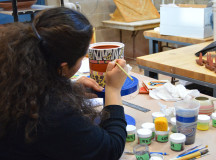
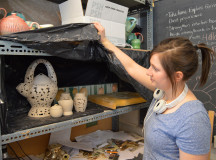
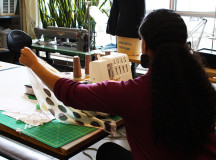
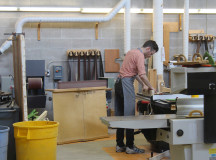
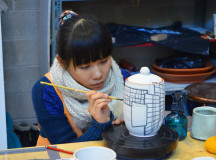

One Response to Lifting Sheridan’s Eco Footprint